There are 10 types of turtles in Delaware, and there are 5 sea turtles that you may observe swimming off the coast. Most of these turtles prefer living in specific waterways, the First State also has a population of terrestrial Eastern Box turtles.
The United States has more turtle species than any other country, and every state has a wide variety. You may see turtles in waterways, in the ocean, or while you’re out hiking through the wilderness if you keep your eyes open. Come with me as we explore the 15 turtles you could see in Delaware.
Table of Contents
Turtles In Delaware
1. Common Snapping Turtle
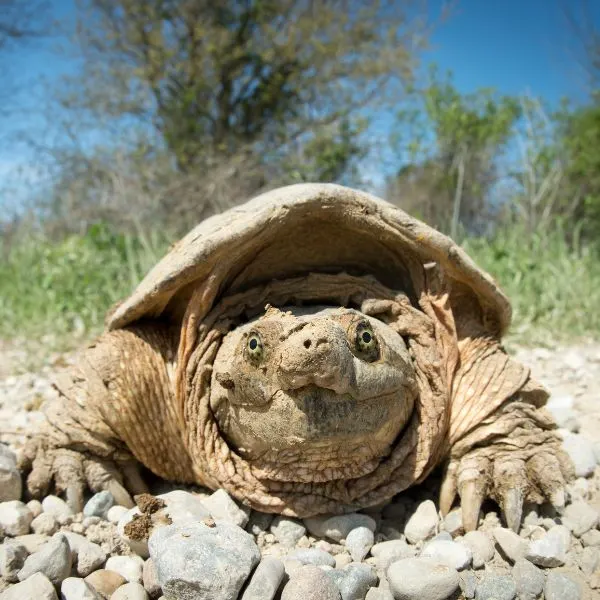
- Experience level: Intermediate to Expert
- Family: Chelydrida
- Scientific Name: Chelydra Serpentina
- Other Names: Snapping Turtle, Snapper, Eastern Snapping Turtle
- Average Adult Size: 8 to 20 inches
- Life Span: 30 – 50 years
- Average Price Range: Approximately $40 to $120
- Conservation Status: Least concern
The Common Snapping turtle is very widespread throughout Delaware, but you may never see one in the wild. They don’t like to leave the water very often. Most of the time, they will even bask without leaving the water.
Females will leave the water after breeding to find a suitable nesting site. They like areas with soft sandy banks where they can deposit their eggs, and will often travel long distances to find what they are looking for.
If you happen to see a Snapping turtle in the wild, the best thing to do is leave it alone. Though they are shy animals, they can be aggressive when out of the water. This is due to the fact that their shell, though thick, does not cover their large limbs and very long tails, and they are quite vulnerable out of the water.
Snapping turtles are dark green to black, and have a solid colored top shell (carapace). Often you may see algae on the shell because of how long they sit at the bottom waiting for food to swim by.
Younger snapping turtles have up to three ridges along the carapace, but they dwindle with age, becoming nearly unnoticeable well into the late adult stages.
Nearly any waterway is suitable for the Snapper, including brackish water. They do prefer slow moving waters such as lakes, ponds, slow rivers, and oxbows with soft bottoms and vegetation.
As adults, the Common Snapping turtle likes to wait for prey to come close. When anything swims nearby the Common Snapping Turtle will strike and snap up the food. They eat nearly anything they can fit into their jaws including fish, amphibians, crustaceans, mollusks, insects, and even other, small turtles. They also eat some vegetation but most of their diet consists of meat.
2. Eastern Musk Turtle
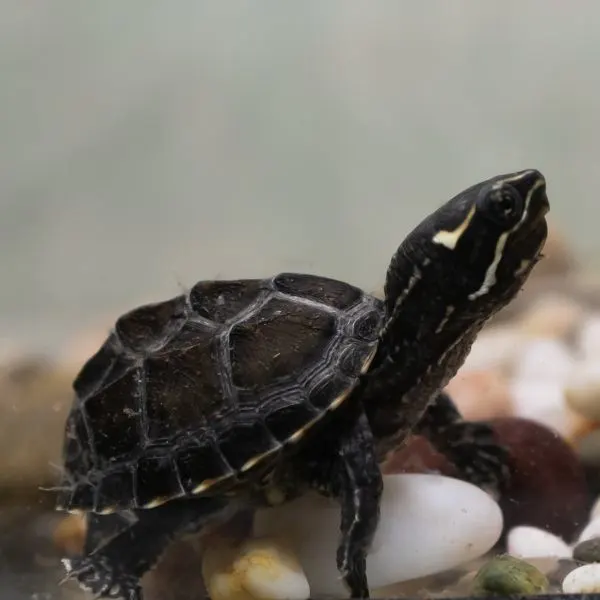
- Experience Level: Intermediate
- Family: Kinosternidae
- Scientific Name: Sternotherus odoratus
- Other Names: Common Musk turtle, Stinkpot
- Adult Size: 4 to 5 inches (10 to 12.5 cm)
- Lifespan: 30 to 50 years
- Average Price Range: $30 to $120
- Conservation Status: Least concern
The small Eastern Musk Turtle turtle loves to wander around on the bottom of small bodies of water such as drainage ditches, small streams, ponds, and other areas of slow moving water with lots of vegetation.
They are small aquatic turtles that blend in well with the muddy bottoms where they live. Their shells are slightly domed and may have ridges running down them. The carapace is dark brown or dark olive green with unpatterned black markings.
Their skin is usually the same color, except they have pairs of white stripes running along the sides. These aren’t racing stripes as this turtle isn’t the fastest or most graceful of swimmers.
They like to scamper along the vegetation and use it to climb to the surface for air. When out of the water, these turtles will even climb low lying trees and shrubs for protection, rest, and to look for food.
The Musk turtle has an endearing nickname (unless you’ve experienced the musk firsthand, then the name aptly fits). Its name, the Stinkpot, comes because it can release a disgusting smelling musk when it feels very threatened.
They eat plenty of small animals such as clams, crayfish, tadpoles, insects, small fish, carrion, and aquatic vegetation.
In the winter the Stinkpot will bury itself in the mud and brumate there. On warmer winter days they may emerge to bask and feed, then they will go back into the muddy hole when it gets cold again.
3. Eastern Mud Turtle

- Experience Level: Beginner
- Family: Kinosternidae
- Scientific Name: Kinosternon subrubrum
- Other Names: Common mud turtle
- Adult Size: 3 to 4 inches
- Lifespan: 40 to 50 years
- Average Price Range: $20 – $100
- Conservation Status: Least concern
The Eastern Mud Turtle is a very small, mostly non-descript turtle. Because of this, it’s often misidentified. They have a small, double-hinged plastron (bottom shell) and a brown, yellowish, or black carapace lacking any defining characteristics.
The skin along the head and throat is grey, or yellowish, with mottled grey markings. They only grow to about 4 inches long, rarely leave the water, and are seldom seen basking.
The Eastern Mud turtle’s favorite watery habitats include rivers, lakes, small streams, and swamps; mostly areas with clean, very oxygenated water with muddy or sandy bottoms. These little turtles can tolerate brackish water as well.
When hibernating, Eastern Mud turtles leave the water to find soft banks or muddy areas covered in leaves or pine needles. There they burrow in the mud and stay until the area warms up again.
The Eastern Mud turtle is omnivorous and will eat algae, vegetation, snails and slugs, insects, small amphibians and tadpoles, as well as crustaceans, and carrion.
4. Eastern Box Turtle
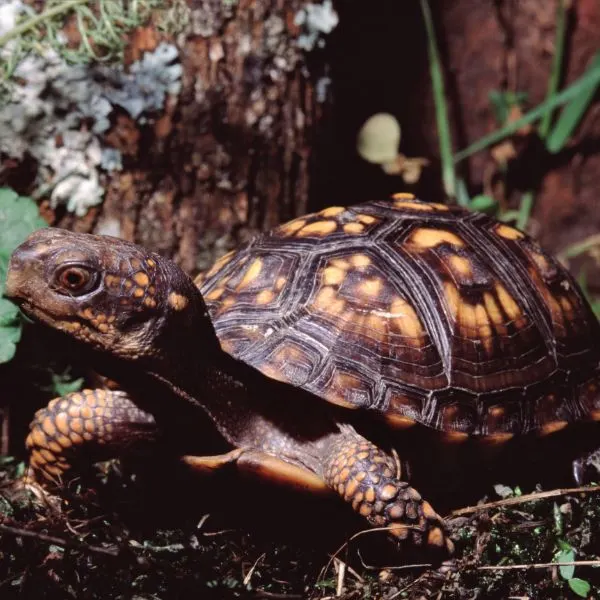
- Experience Level: Beginner
- Family: Emydidae
- Scientific Name: Terrapene carolina carolina
- Other Names: Land Turtle
- Adult Size: 4 to 7 inches
- Lifespan: 50 to 100 years
- Average Price Range: $260 – $360
- Conservation Status: Michigan, New Hampshire, Massachusetts, and Connecticut—list the animal as a species of special concern, and Maine lists the turtle as endangered.
Delaware’s only terrestrial turtle is the Eastern Box Turtle. It spends almost all its life wandering the forest floor. They can swim, but not very well, and only enter the water to cool off or to get a drink.
Eastern Box turtles are beautiful small turtles that have a highly domed carapace that’s usually black, or dark green with yellow, orange, or red markings on each scute. Each one has a different look that’s almost as unique as fingerprints.
They also have brightly colored spots and markings on their heads and limbs. Males often have red irises, while females often have yellowish or brown irises, though this isn’t a definitive way to tell the sex.
Most times females are larger than males but have a smaller, shorter tail. Male box turtles have a concave plastron, while females have a flat bottom shell.
Like the common mud turtle, this little reptile has a double hinged plastron and can pull its entire body into the shell. When threatened, the turtle will lock itself in the shell, and most predators can’t get in.
The Eastern box turtle prefers damp forests, meadows, and woodlands where it searches for worms, grubs, insects, spiders, fungi, berries, plants, and even carrion to eat. Though they can travel far distances in the search for food, this turtle rarely travels more than a few hundred yards from where it was born.
5. Eastern Painted Turtle
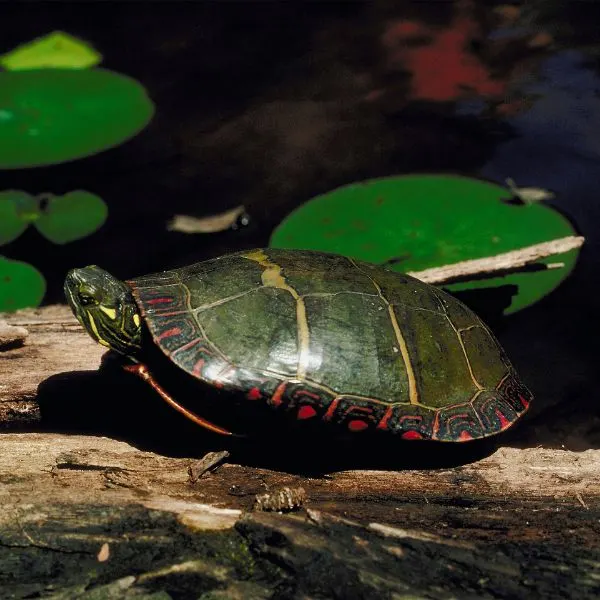
- Experience level: Beginner
- Family: Emydidae
- Scientific Name: Chrysemys picta picta
- Common Name: Painted Turtle
- Average Adult Size: 4 – 10 inches
- Life Span: 30 – 50 years
- Average Price Range: Between $30 to $150
- Conservation Status: Least Concern
The Eastern Painted Turtle is the most common turtle found in Delaware, and indeed the entire United States. They can be found in waterways from Canada to Mexico, and from the East to West coasts. You’ll probably see them crowded along floating logs, rocky outcroppings, or along soft, sandy banks basking and absorbing the sun’s rays.
When they feel threatened they quickly retreat back into the water. They are a medium sized turtle, often reaching lengths of 9 to 10 inches.
Painted turtles have smooth, dark colored, to black carapaces that are slightly flattened. Their scutes align along the back and they have dark skin with plentiful yellow, or whitish stripes along their limbs, head, and neck. Their plastrons are brightly colored, either yellow, orange, or red with no patterns.
These turtles prefer larger, slow moving lakes, rivers, and ponds with lots of vegetation. They are omnivorous but tend to eat more vegetation than insects, crustaceans, fish, and mollusks.
Painted turtles can hold their breath for a very long time. They can also remain submerged through hibernation or brumation for up to 4 months without a breath. They can do this by absorbing oxygen through their skin, their mouth (buccal breathing), and through their cloaca.
Some turtles have the ability to absorb oxygen from the water through “butt breathing.” These turtles have special areas in their cloaca that are able to extract oxygen and release carbon dioxide and other waste gasses from their backside.
6. Northern Red-Bellied Cooter
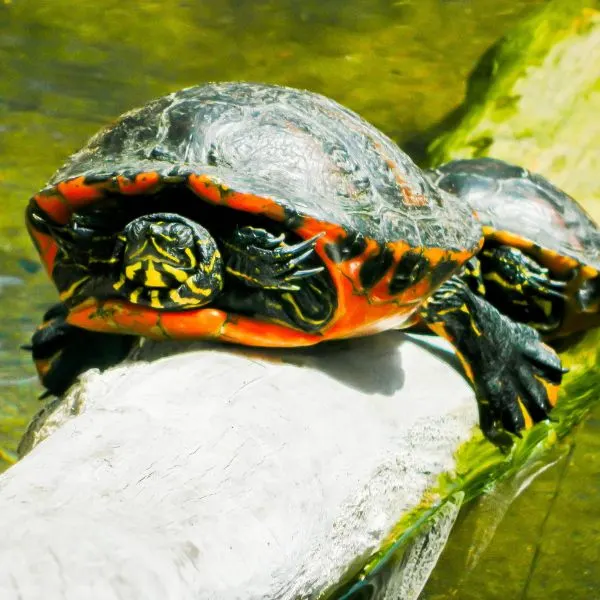
- Experience Level: Beginner to Intermediate
- Family: Emydidae
- Scientific Name: Pseudemys rubriventris
- Other Names: American red-bellied turtle
- Adult Size: Between 8 and 12 inches
- Lifespan: Between 40 and 55 years
- Average Price Range: Between $30 and $170
- Conservation Status: Near threatened
Red-bellied cooters may look similar to painted turtles, but you can identify them because their carapace usually has bright patterns, although these often fade as the years go by. If you look at their plastron you’ll notice bright red coloration, but unlike painted turtles, the Red-Bellied Cooter has matching black, or dark green patterns.
These patterns are probably where scientists came up with Rorschach tests. Eh, probably not, but who knows?
These turtles also have colors on their skin very similar to painted turtles, but if you look carefully, you may notice an arrow shape pointing toward the Red-Bellied Cooter’s snout.
These turtles like to inhabit still, freshwater lakes, streams, and rivers, but some may venture into brackish water. Some Red-Bellies have been observed with barnacles on their shells, meaning they have encountered and lingered in salty waters.
The diet of Red-Bellied Cooters changes as they age. Young and juvenile Red-Bellies eat mostly insects, crayfish, and mollusks. As they age into adulthood, they start eating more vegetation. They still are omnivorous, but the main part of their diet includes plant matter and algae.
7. Northern Diamondback Terrapin
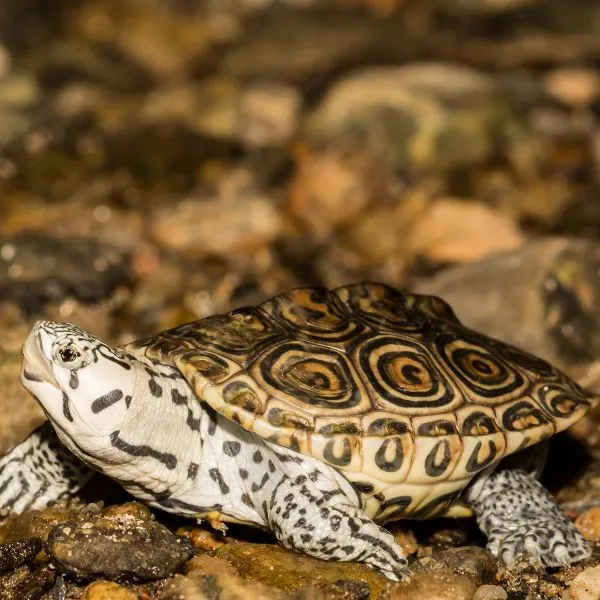
- Experience Level: Beginner to Intermediate
- Family: Emydidae
- Scientific Name: Malaclemys terrapin terrapin
- Other Names: Diamond-backed terrapin
- Adult Size: 4.5 to 9 inches (11.5 to 23 cm)
- Lifespan: 25 to 40 years
- Average Price Range: $250 to $600
- Conservation Status: Special concern
The Diamondback terrapin is a turtle specifically specialized for brackish and salty environments. It’s the only turtle in Delaware that lives exclusively in brackish water.
These turtles have raised scutes along their backs which gives them their name. They are an absolutely gorgeous turtle species, which makes them very popular as pets, but they are federally protected in many states.
In Delaware, you can own a Diamondback Terrapin, but you have to obtain a special permit, and you are absolutely forbidden to take them or their eggs from the wild.
These turtles have light to dark colored carapaces with black concentric rings or circles on their scutes. Their skin is usually light grey with black spots and markings. Their shell is wider at the back, and they have wide, webbed feet.
You may find the Diamondback Terrapin in salt marshes, tidal pools/flats, and brackish streams.
To deal with the saltwater they consume, these turtles have specialized ducts at their eyes that secrete excess salt. When drinking water they will either crawl onto the shore during a rain shower and open their mouth to catch raindrops or swim to the surface of brackish waters to drink the fresh layer produced by rain.
Females are nearly twice as big as males, but male terrapins have longer tails.
These turtles are mostly carnivorous. They will eat crustaceans such as crabs, shrimp, and clams, as well as fish, carrion, and worms. Occasionally they will graze on vegetation.
8. Red Eared Slider
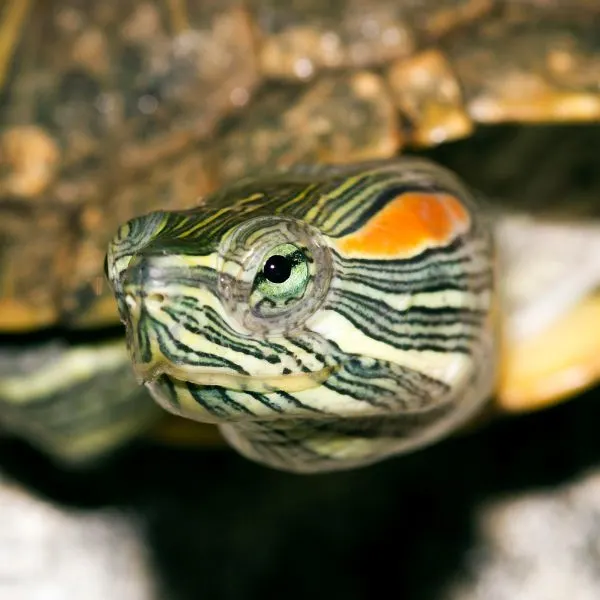
- Experience level: Beginner
- Family: Emydidae
- Scientific Name: Trachemys scripta elegans
- Common Name: Pond slider, Red-eared terrapin, Water slider
- Average Adult Size: 6 – 8 inches
- Life Span: 20 to 40 years
- Average Price Range: approximately $30 to $100
- Conservation Status: Least concern
As popular as Red Eared sliders once were back in the 70s and 80s, I’m surprised these aren’t the most populous turtles in the nation. They were sold in stores everywhere for pennies, and so many parents bought them for their children. Only the parents didn’t know that turtles can live for a very long time and that aquatic turtles need a lot of care.
Red Eared Sliders were released in the wild all over the place, and most of them became invasive non-native species. Just a little lesson about not releasing turtles into the wild. If for some reason you can’t care for your pets, please take them to a veterinarian or adoption agency.
Back to the turtles! Red Eared Sliders are not native to Delaware and were most likely introduced by owners who could no longer care for them. Unfortunately, Red Eared sliders can out compete many native turtles.
In Delaware to own this turtle, you need to obtain a permit because they are considered an exotic species.
Red Eared sliders look very similar to Painted turtles, though they are generally smaller. The main identifying feature is the red, elongated spots behind their eyes. These spots look like ears and is where the turtle gets its name.
These turtles are habitat generalists. They live in the water but can inhabit almost any freshwater habitat.
They are omnivorous and will eat nearly anything including fish, crayfish, mollusks, insects, worms, carrion, and vegetation.
9. Spiny Softshell Turtle
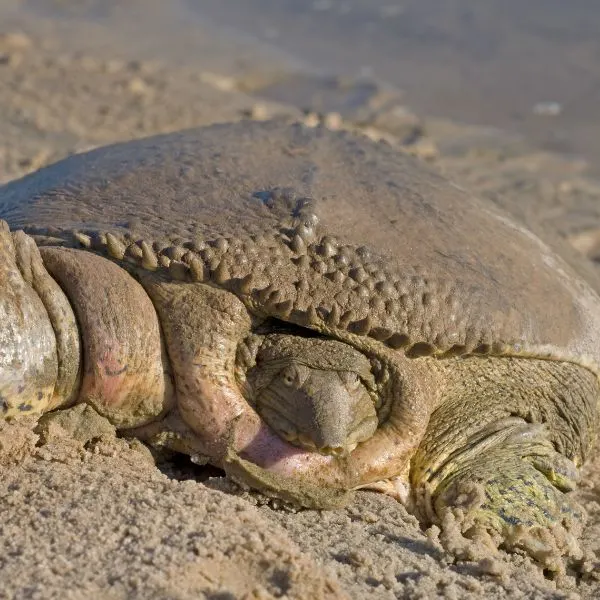
- Experience Level: Intermediate to Expert
- Family: Trionychidae
- Scientific Name: Apalone spinifera
- Other Names: N/A
- Adult Size: 5 to 9 ½ inches for males, 10 to 20 inches for females
- Lifespan: Between 20 and 50 years
- Average Price Range: Between $20 and $120
- Conservation Status: Least concern
Another non-native species is the Spiny Softshell turtle. These are so named because of the fleshy knobs located on the front ridge, and sometimes along the front half of the carapace. These spines won’t poke you, but this turtle may give you a nasty bite.
Though naturally a shy turtle, if they are taken from the water they can become very aggressive. They will hiss, and bite if given the chance. They have very long necks and a sharp beak that can easily pierce the skin.
These turtles are easily recognizable because they look like rubbery pancakes. They range in color from tan to olive and usually have black spots along the back. Their skin is the same color though they have lighter colored stripes along the head and neck.
Spiny Softshell turtles prefer rivers, streams, or lakes with sandy bottoms relatively devoid of vegetation. They often bury themselves in the sand and wait for food to swim nearby. When anything small enough to fit in their mouths swims by, they ambush it and eat it.
They are omnivorous by nature but prefer live prey including fish, amphibians, crayfish, tadpoles, and insects.
Softshell turtles are the second largest freshwater turtles in America. Only the Alligator Snapping turtle gets larger. Females can reach lengths of nearly 20 inches long and are nearly double the size of full grown males.
10. Spotted Turtle

- Experience Level: Intermediate to Expert
- Family: Emydidae
- Scientific Name: Clemmys guttata
- Other Names: Polka-dot turtle, “Spotty”
- Adult Size: 4 to 5 inches
- Lifespan: Males up to 65 years; females up to 110 years
- Average Price Range: $200 to $300
- Conservation Status: Endangered
The Spotted Turtle is an endangered species of turtle that is in decline around the US. In many states, it’s unlawful to possess endangered animals. For more information concerning this and other species in Delaware, please check out Delaware Department of Natural Resources.
Spotted turtles are small, semi-aquatic turtles that live on land and in the water. They are quite popular in the pet trade, and many are poached from the wild to be sold for a big profit. Unfortunately, wild caught spotties don’t fare well in captivity.
They can stress out after being captured, refuse to eat, and quickly decline in health.
These turtles have dark carapaces with spots on their scutes. The scutes can have a single or multiple spots depending on the individual turtle. Their skin is usually the same coloration with the same colored spots throughout.
Spotties prefer marshes, swamps, meadows, as well as lakes and streams. Though they spend plenty of time on land, they will only eat while submerged. Here these little turtles eat fish, tadpoles, snails and slugs, insects, and some vegetation.
On land, they will bask in mossy patches and the females of this species lay their eggs in soft meadows. When they are threatened they will retreat back into the water and bury themselves in sandy or muddy bottoms.
Sea Turtles Of Delaware
If you’re lucky you may see one or more of 5 different sea turtle species off the coast of Delaware. These turtles don’t nest here, but they often can be seen as they come to the surface for a breath of air. Here are the following sea turtles and some information about them.
11. Green Sea Turtle

- Experience level: N/A, Illegal to own any sea turtle
- Family: Cheloniidae
- Scientific Name: Chelonia mydas
- Other Names: Green Sea Turtle
- Average Adult Size: 3 – 4 feet
- Life Span: 50 – 70 years
- Average Price Range: N/A
- Conservation Status: Endangered
The Green Sea turtle has very little green on its shell and body. Their shells are usually varying shades of green, black, and brown, and they have white skin with brown or black scales. They are called green because of the color of the fat underneath.
Their tissue becomes green over time because these turtles feed almost exclusively on algae and sea grasses. Baby and juvenile Green Sea turtles eat more meat and gradually shift over to a mostly herbivorous diet as they age.
12. Loggerhead Sea Turtle

- Experience Level: N/A, Illegal to own any sea turtle
- Family: Cheloniidae
- Scientific Name: Caretta Caretta
- Other Names: Loggerhead
- Adult Size: 3 – 5 feet
- Lifespan: 70 – 80 years
- Average Price Range: N/A
- Conservation Status: Endangered
Loggerhead sea turtles have large, blunt heads. They have huge jaw muscles to help them crack open thick conch, whelk, and horseshoe crab shells. They almost exclusively eat these hard-shelled creatures.
Loggerhead sea turtles are a rare sight because they prefer open oceans and often avoid people, though they do nest and lay eggs in Florida and other tropical beaches around the world.
While these aren’t the largest sea turtles, they are the biggest hard-shelled sea turtles. Though it’s very rare to find them very big anymore, they used to reach lengths of nearly 6 feet long and could weigh roughly 1,000 pounds.
13. Kemp’s Ridley Sea Turtle

- Experience level: N/A, Illegal to own any sea turtle
- Family: Cheloniidae
- Scientific Name: Lepidochelys kempii
- Other Names: Atlantic Ridley, Tortuga Lora (Mexico)
- Average Adult Size: 24 – 27 inches
- Life Span: 30 years
- Average Price Range: N/A
- Conservation Status: Critically endangered
Next is Kemp’s Ridley sea turtle. These are the smallest of the sea turtles, and the most critically endangered of them all. Currently, there are only about 250 nesting females, so there are big efforts to save them.
One good thing these turtles have going for them is they all nest at relatively the same time. This process is called Arribada and helps to protect them and their babies from predators. The baby turtles tend to hatch all at the same time as well.
Kemp’s Ridley sea turtles eat fish, shrimp, crustaceans, sea stars, jellyfish, snails, and clams.
14. Atlantic Leatherback Sea Turtle

- Experience level: N/A, Illegal to own any sea turtle
- Family: Dermochelyidae
- Scientific Name: Dermochelys coriacea
- Other Names: Atlantic Leatherback, Leatherback
- Average Adult Size: 4 – 8 ft
- Life Span: 30 – 50 years
- Average Price Range: N/A
- Conservation Status: Endangered
The Atlantic Leatherback is the largest turtle species alive today. These massive creatures can grow to nearly 8 feet long and weigh up to 6,000 pounds.
They don’t have a hard shell, instead, their bony plates are covered by a leathery skin. They are massive and have black skin with white spots all over.
The Leatherback turtle can swim for tens of thousands of miles as they search for food and then come back to nest on the western shores of America. Though they are very large, they are fast swimmers, and relatively fast on the land as well.
A Leatherback’s diet consists almost exclusively of jellyfish, specifically the lion’s mane jellyfish. These animals can grow to 8 feet in diameter. This turtle can consume up to 600 of these jellyfish in a single day. Though I doubt they could eat that many 8 footers!
15. Hawksbill Sea Turtle

- Experience level: N/A, Illegal to own any sea turtle
- Family: Cheloniidae
- Scientific Name: Eretmochelys imbricata
- Other Names: Hawksbill
- Average Adult Size: 30 – 36 inches
- Life Span: 50 – 60 years
- Average Price Range: N/A
- Conservation Status: Critically endangered
Along Delaware’s coast, especially in the coral reefs, you may be able to see the Hawksbill Sea turtle eating sponges, jellyfish, small fish, and crustaceans. These gorgeous turtles have a marbled shell, and a sharp, hooked beak—hence their name—yellow, white, or green skin with darker colored scales.
Their beautiful shells unfortunately contribute to their declining numbers. Many humans still poach these turtles for their shells only. The shells are carved down and polished to make tortoiseshell hair accessories such as combs and picks, eyeglasses frames, and other items.
Another reason for their dwindling numbers is that they only nest every 2 to 5 years. Most sea turtles take a season or two off from nesting because it’s so stressful and exhausting, but the hawksbill takes the most time between nesting.
FAQs
Is it legal to sell turtles in Delaware?
You can sell turtles in Delaware only if you have a permit to do so. You can also own turtles in Delaware, though some species are protected and it’s unlawful to own them. Check the Delaware Department of Natural Resources for more information on owning and obtaining turtles in Delaware.
Do Alligator Snapping turtles live in Delaware?
Common Snapping turtles live in Delaware, but not the larger, more intimidating cousin the Alligator Snapping turtle. These turtles can be found as far north as Illinois and in the southern states from Florida to Texas.
What is the rarest turtle in the United States?
The rarest turtle is also the smallest turtle in the US, the Bog turtle. These turtles are considered critically endangered and imperiled. There are thought to be less than 2,000 left in the world.
Wrapping up
There you have it, all the turtles you can see in your exploration of the state of Delaware. Turtles are endearing animals, but they need our help to keep their numbers healthy. If you see them in the wild, enjoy seeing them, but please leave them alone.
When purchasing a turtle as a pet, understand they live for a very long time and require plenty of care. Search out rescue agencies if you can, otherwise make sure your turtle breeder is ethical and knowledgeable about turtles.
If you live in, or have visited Delaware and want to share your story please leave us a comment below. If you’ve never been to Delaware and want to say hi, then do that too! We love to hear from our readers!
Other nearby states
